Civil Liability and Negligence: A Case Study of Dr. Stark and Nguyens
VerifiedAdded on 2020/03/28
|11
|2440
|361
Case Study
AI Summary
This case study examines a negligence claim under tort law, focusing on Dr. Stark and the Nguyens. The analysis explores two key issues: whether the Nguyens can successfully claim negligence against Dr. Stark based on the Civil Liability Act, and whether their newborn baby can also make a claim. The document outlines the elements of negligence, including duty of care, breach, causation, and damages, referencing relevant case law such as Donoghue v Stevenson, Paris v Stepney Borough Council, and Rogers v Whitaker. The application section argues that Dr. Stark breached his duty of care by failing to inform the Nguyens about the possibility of recanalization after sterilization, which led to the birth of a child with Down syndrome. The analysis concludes that Dr. Stark is liable for the costs associated with raising and caring for the child, including medical expenses and compensation for the Nguyens' mental distress. Furthermore, the newborn baby is deemed eligible to sue Dr. Stark for negligence, citing cases like Watt v Rama and Lynch v Lynch to support the claim for damages.
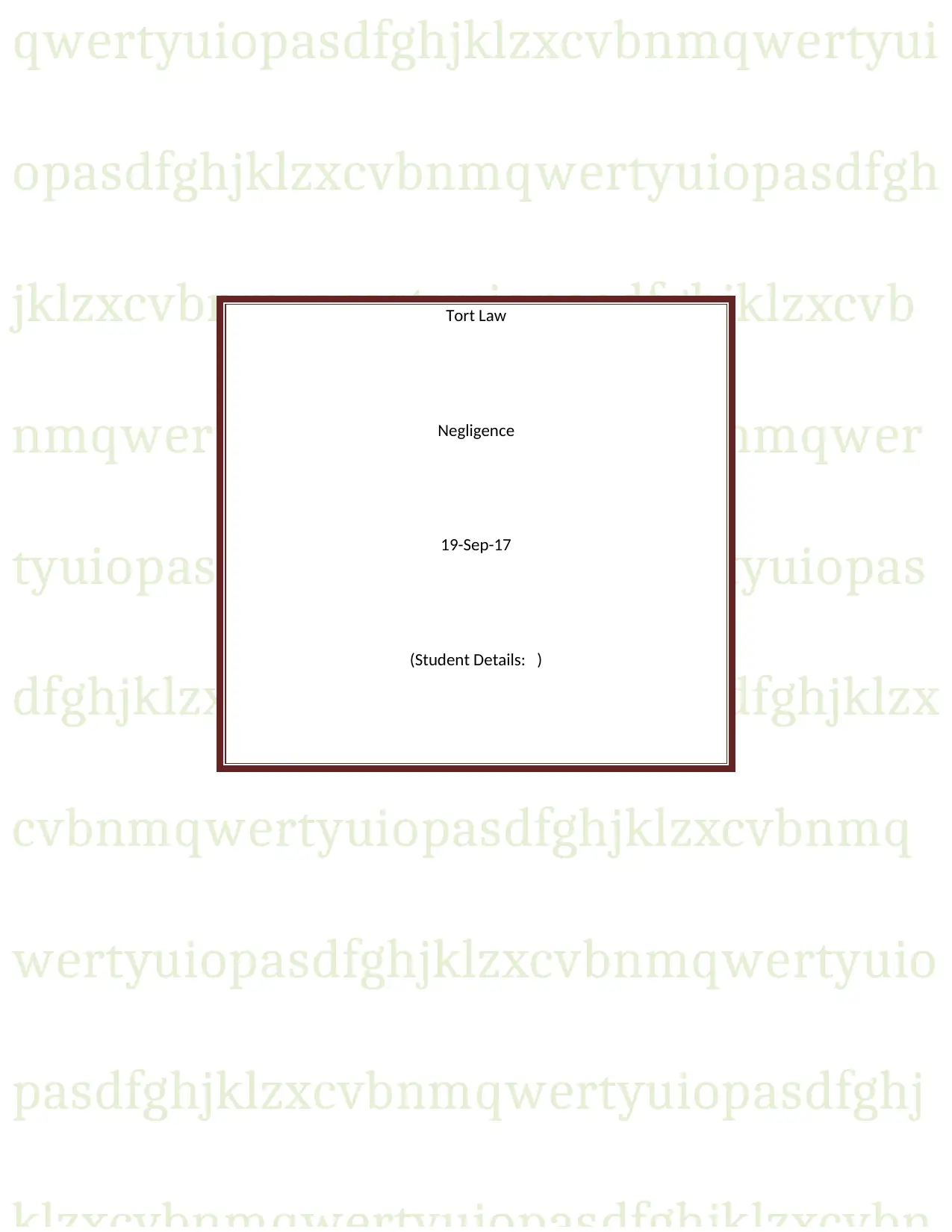
qwertyuiopasdfghjklzxcvbnmqwertyui
opasdfghjklzxcvbnmqwertyuiopasdfgh
jklzxcvbnmqwertyuiopasdfghjklzxcvb
nmqwertyuiopasdfghjklzxcvbnmqwer
tyuiopasdfghjklzxcvbnmqwertyuiopas
dfghjklzxcvbnmqwertyuiopasdfghjklzx
cvbnmqwertyuiopasdfghjklzxcvbnmq
wertyuiopasdfghjklzxcvbnmqwertyuio
pasdfghjklzxcvbnmqwertyuiopasdfghj
Tort Law
Negligence
19-Sep-17
(Student Details: )
opasdfghjklzxcvbnmqwertyuiopasdfgh
jklzxcvbnmqwertyuiopasdfghjklzxcvb
nmqwertyuiopasdfghjklzxcvbnmqwer
tyuiopasdfghjklzxcvbnmqwertyuiopas
dfghjklzxcvbnmqwertyuiopasdfghjklzx
cvbnmqwertyuiopasdfghjklzxcvbnmq
wertyuiopasdfghjklzxcvbnmqwertyuio
pasdfghjklzxcvbnmqwertyuiopasdfghj
Tort Law
Negligence
19-Sep-17
(Student Details: )
Paraphrase This Document
Need a fresh take? Get an instant paraphrase of this document with our AI Paraphraser
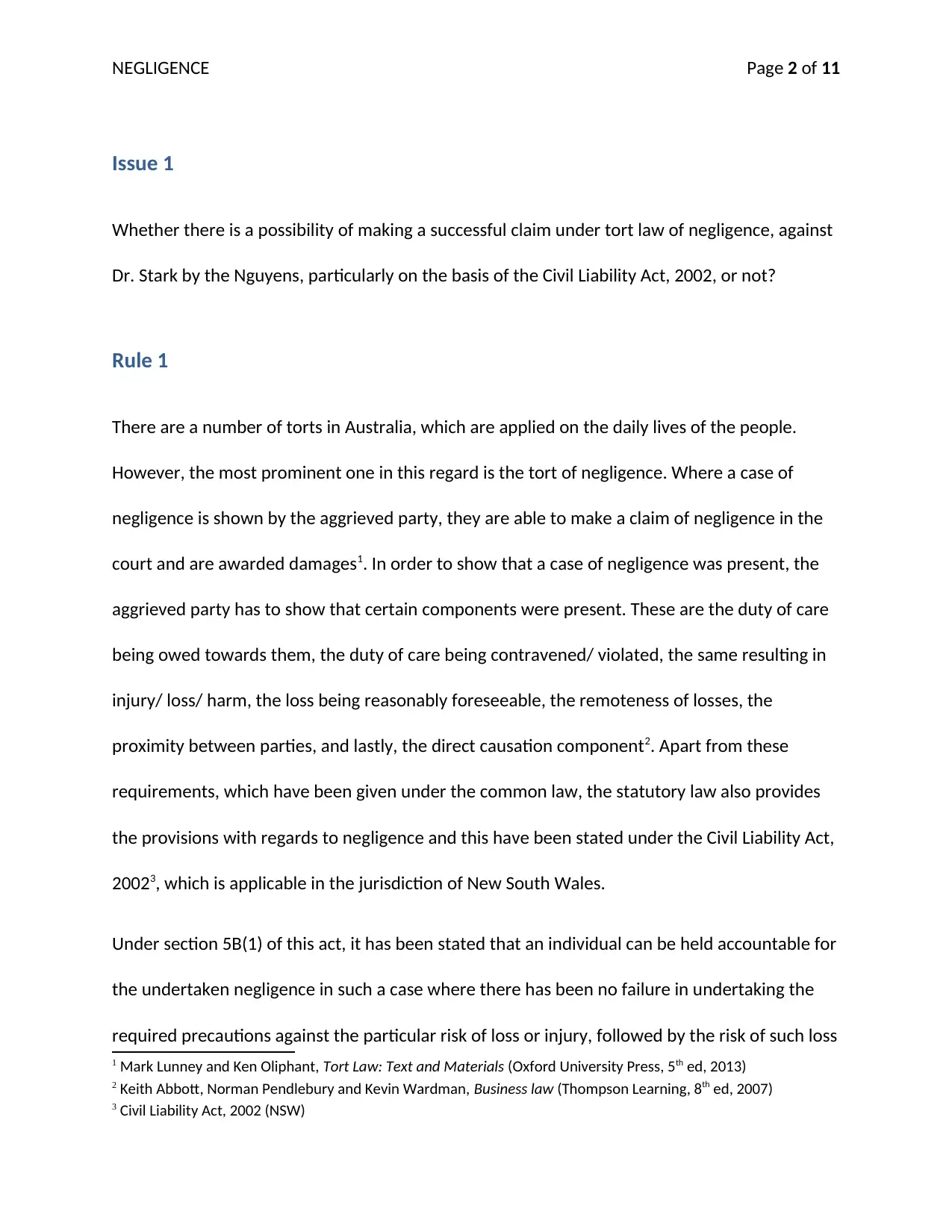
NEGLIGENCE Page 2 of 11
Issue 1
Whether there is a possibility of making a successful claim under tort law of negligence, against
Dr. Stark by the Nguyens, particularly on the basis of the Civil Liability Act, 2002, or not?
Rule 1
There are a number of torts in Australia, which are applied on the daily lives of the people.
However, the most prominent one in this regard is the tort of negligence. Where a case of
negligence is shown by the aggrieved party, they are able to make a claim of negligence in the
court and are awarded damages1. In order to show that a case of negligence was present, the
aggrieved party has to show that certain components were present. These are the duty of care
being owed towards them, the duty of care being contravened/ violated, the same resulting in
injury/ loss/ harm, the loss being reasonably foreseeable, the remoteness of losses, the
proximity between parties, and lastly, the direct causation component2. Apart from these
requirements, which have been given under the common law, the statutory law also provides
the provisions with regards to negligence and this have been stated under the Civil Liability Act,
20023, which is applicable in the jurisdiction of New South Wales.
Under section 5B(1) of this act, it has been stated that an individual can be held accountable for
the undertaken negligence in such a case where there has been no failure in undertaking the
required precautions against the particular risk of loss or injury, followed by the risk of such loss
1 Mark Lunney and Ken Oliphant, Tort Law: Text and Materials (Oxford University Press, 5th ed, 2013)
2 Keith Abbott, Norman Pendlebury and Kevin Wardman, Business law (Thompson Learning, 8th ed, 2007)
3 Civil Liability Act, 2002 (NSW)
Issue 1
Whether there is a possibility of making a successful claim under tort law of negligence, against
Dr. Stark by the Nguyens, particularly on the basis of the Civil Liability Act, 2002, or not?
Rule 1
There are a number of torts in Australia, which are applied on the daily lives of the people.
However, the most prominent one in this regard is the tort of negligence. Where a case of
negligence is shown by the aggrieved party, they are able to make a claim of negligence in the
court and are awarded damages1. In order to show that a case of negligence was present, the
aggrieved party has to show that certain components were present. These are the duty of care
being owed towards them, the duty of care being contravened/ violated, the same resulting in
injury/ loss/ harm, the loss being reasonably foreseeable, the remoteness of losses, the
proximity between parties, and lastly, the direct causation component2. Apart from these
requirements, which have been given under the common law, the statutory law also provides
the provisions with regards to negligence and this have been stated under the Civil Liability Act,
20023, which is applicable in the jurisdiction of New South Wales.
Under section 5B(1) of this act, it has been stated that an individual can be held accountable for
the undertaken negligence in such a case where there has been no failure in undertaking the
required precautions against the particular risk of loss or injury, followed by the risk of such loss
1 Mark Lunney and Ken Oliphant, Tort Law: Text and Materials (Oxford University Press, 5th ed, 2013)
2 Keith Abbott, Norman Pendlebury and Kevin Wardman, Business law (Thompson Learning, 8th ed, 2007)
3 Civil Liability Act, 2002 (NSW)
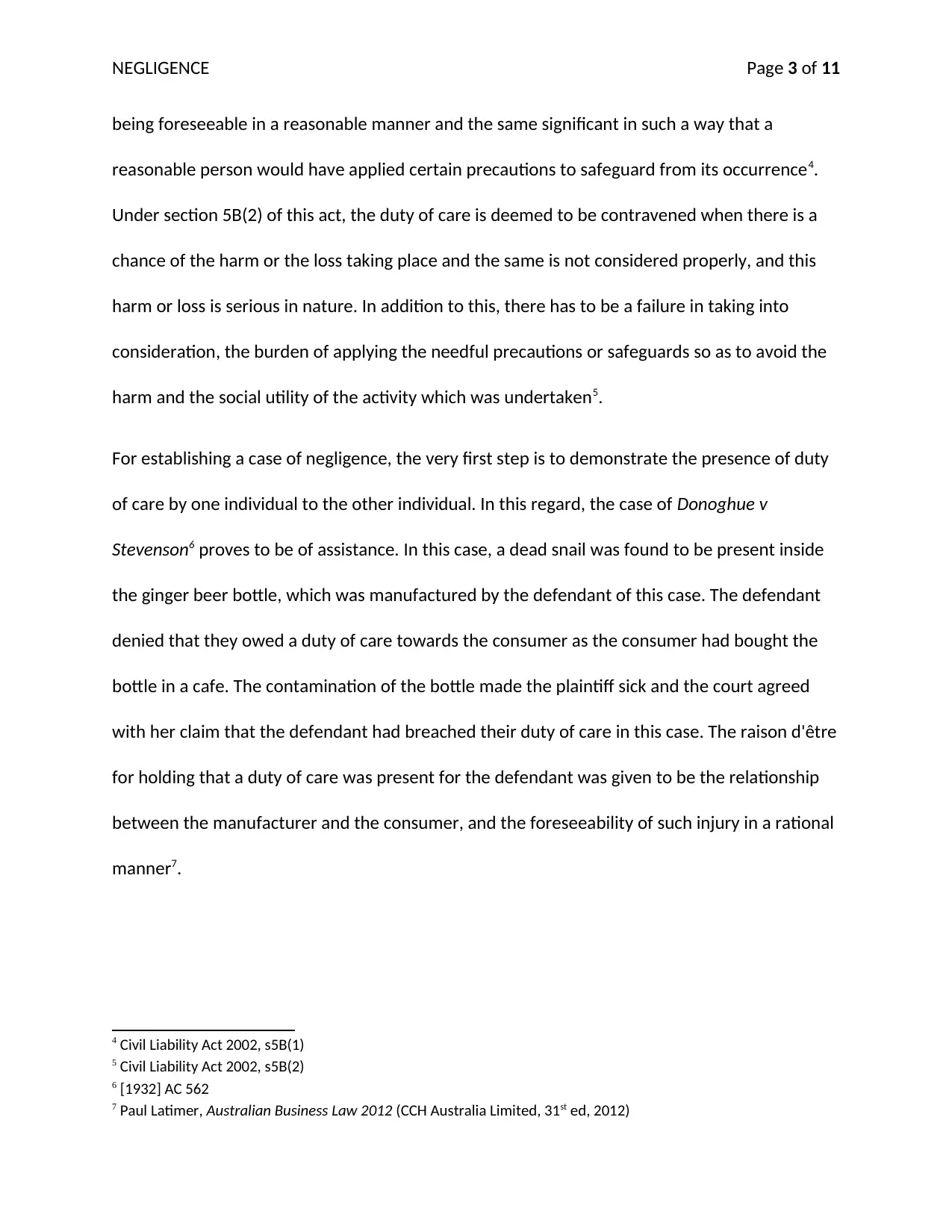
NEGLIGENCE Page 3 of 11
being foreseeable in a reasonable manner and the same significant in such a way that a
reasonable person would have applied certain precautions to safeguard from its occurrence4.
Under section 5B(2) of this act, the duty of care is deemed to be contravened when there is a
chance of the harm or the loss taking place and the same is not considered properly, and this
harm or loss is serious in nature. In addition to this, there has to be a failure in taking into
consideration, the burden of applying the needful precautions or safeguards so as to avoid the
harm and the social utility of the activity which was undertaken5.
For establishing a case of negligence, the very first step is to demonstrate the presence of duty
of care by one individual to the other individual. In this regard, the case of Donoghue v
Stevenson6 proves to be of assistance. In this case, a dead snail was found to be present inside
the ginger beer bottle, which was manufactured by the defendant of this case. The defendant
denied that they owed a duty of care towards the consumer as the consumer had bought the
bottle in a cafe. The contamination of the bottle made the plaintiff sick and the court agreed
with her claim that the defendant had breached their duty of care in this case. The raison d'être
for holding that a duty of care was present for the defendant was given to be the relationship
between the manufacturer and the consumer, and the foreseeability of such injury in a rational
manner7.
4 Civil Liability Act 2002, s5B(1)
5 Civil Liability Act 2002, s5B(2)
6 [1932] AC 562
7 Paul Latimer, Australian Business Law 2012 (CCH Australia Limited, 31st ed, 2012)
being foreseeable in a reasonable manner and the same significant in such a way that a
reasonable person would have applied certain precautions to safeguard from its occurrence4.
Under section 5B(2) of this act, the duty of care is deemed to be contravened when there is a
chance of the harm or the loss taking place and the same is not considered properly, and this
harm or loss is serious in nature. In addition to this, there has to be a failure in taking into
consideration, the burden of applying the needful precautions or safeguards so as to avoid the
harm and the social utility of the activity which was undertaken5.
For establishing a case of negligence, the very first step is to demonstrate the presence of duty
of care by one individual to the other individual. In this regard, the case of Donoghue v
Stevenson6 proves to be of assistance. In this case, a dead snail was found to be present inside
the ginger beer bottle, which was manufactured by the defendant of this case. The defendant
denied that they owed a duty of care towards the consumer as the consumer had bought the
bottle in a cafe. The contamination of the bottle made the plaintiff sick and the court agreed
with her claim that the defendant had breached their duty of care in this case. The raison d'être
for holding that a duty of care was present for the defendant was given to be the relationship
between the manufacturer and the consumer, and the foreseeability of such injury in a rational
manner7.
4 Civil Liability Act 2002, s5B(1)
5 Civil Liability Act 2002, s5B(2)
6 [1932] AC 562
7 Paul Latimer, Australian Business Law 2012 (CCH Australia Limited, 31st ed, 2012)
⊘ This is a preview!⊘
Do you want full access?
Subscribe today to unlock all pages.

Trusted by 1+ million students worldwide
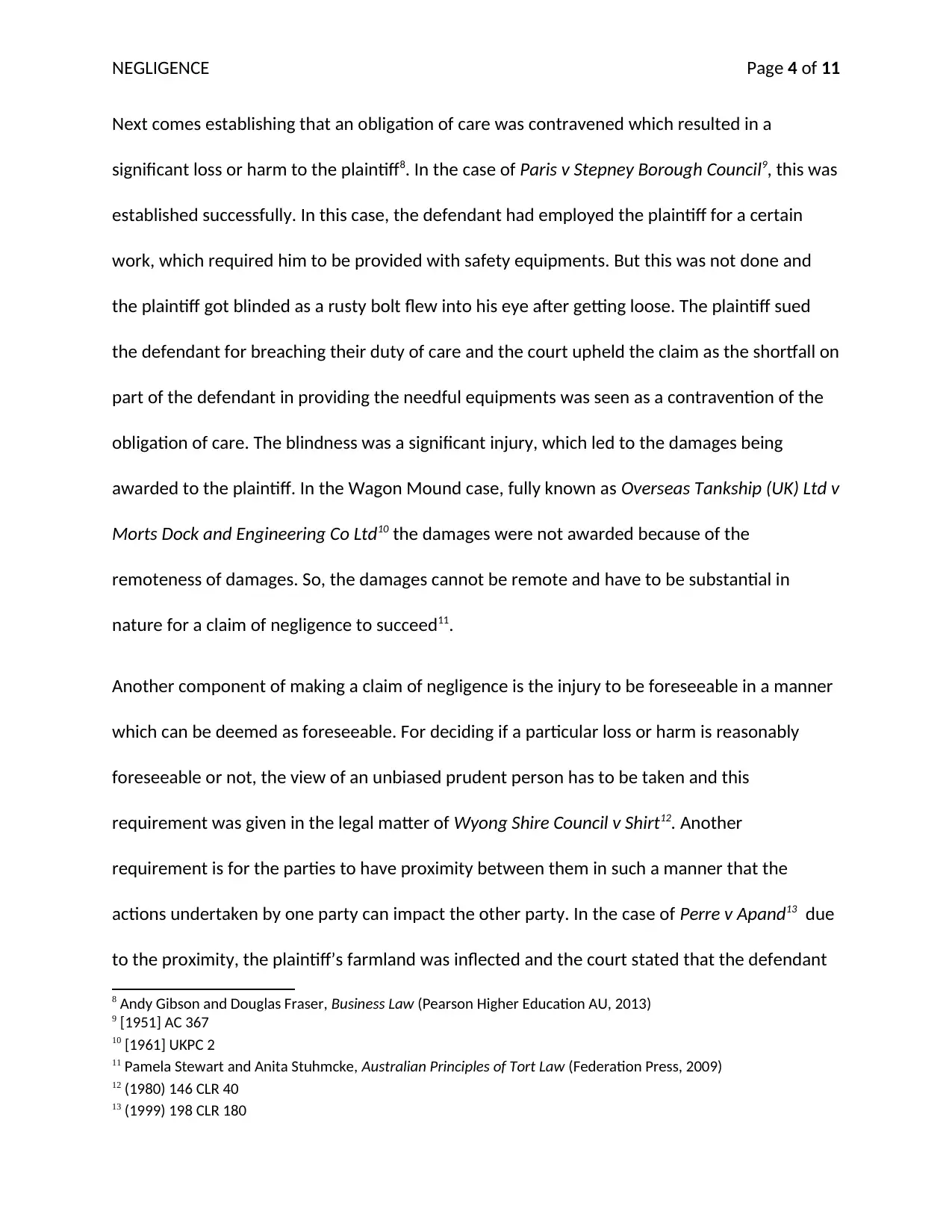
NEGLIGENCE Page 4 of 11
Next comes establishing that an obligation of care was contravened which resulted in a
significant loss or harm to the plaintiff8. In the case of Paris v Stepney Borough Council9, this was
established successfully. In this case, the defendant had employed the plaintiff for a certain
work, which required him to be provided with safety equipments. But this was not done and
the plaintiff got blinded as a rusty bolt flew into his eye after getting loose. The plaintiff sued
the defendant for breaching their duty of care and the court upheld the claim as the shortfall on
part of the defendant in providing the needful equipments was seen as a contravention of the
obligation of care. The blindness was a significant injury, which led to the damages being
awarded to the plaintiff. In the Wagon Mound case, fully known as Overseas Tankship (UK) Ltd v
Morts Dock and Engineering Co Ltd10 the damages were not awarded because of the
remoteness of damages. So, the damages cannot be remote and have to be substantial in
nature for a claim of negligence to succeed11.
Another component of making a claim of negligence is the injury to be foreseeable in a manner
which can be deemed as foreseeable. For deciding if a particular loss or harm is reasonably
foreseeable or not, the view of an unbiased prudent person has to be taken and this
requirement was given in the legal matter of Wyong Shire Council v Shirt12. Another
requirement is for the parties to have proximity between them in such a manner that the
actions undertaken by one party can impact the other party. In the case of Perre v Apand13 due
to the proximity, the plaintiff’s farmland was inflected and the court stated that the defendant
8 Andy Gibson and Douglas Fraser, Business Law (Pearson Higher Education AU, 2013)
9 [1951] AC 367
10 [1961] UKPC 2
11 Pamela Stewart and Anita Stuhmcke, Australian Principles of Tort Law (Federation Press, 2009)
12 (1980) 146 CLR 40
13 (1999) 198 CLR 180
Next comes establishing that an obligation of care was contravened which resulted in a
significant loss or harm to the plaintiff8. In the case of Paris v Stepney Borough Council9, this was
established successfully. In this case, the defendant had employed the plaintiff for a certain
work, which required him to be provided with safety equipments. But this was not done and
the plaintiff got blinded as a rusty bolt flew into his eye after getting loose. The plaintiff sued
the defendant for breaching their duty of care and the court upheld the claim as the shortfall on
part of the defendant in providing the needful equipments was seen as a contravention of the
obligation of care. The blindness was a significant injury, which led to the damages being
awarded to the plaintiff. In the Wagon Mound case, fully known as Overseas Tankship (UK) Ltd v
Morts Dock and Engineering Co Ltd10 the damages were not awarded because of the
remoteness of damages. So, the damages cannot be remote and have to be substantial in
nature for a claim of negligence to succeed11.
Another component of making a claim of negligence is the injury to be foreseeable in a manner
which can be deemed as foreseeable. For deciding if a particular loss or harm is reasonably
foreseeable or not, the view of an unbiased prudent person has to be taken and this
requirement was given in the legal matter of Wyong Shire Council v Shirt12. Another
requirement is for the parties to have proximity between them in such a manner that the
actions undertaken by one party can impact the other party. In the case of Perre v Apand13 due
to the proximity, the plaintiff’s farmland was inflected and the court stated that the defendant
8 Andy Gibson and Douglas Fraser, Business Law (Pearson Higher Education AU, 2013)
9 [1951] AC 367
10 [1961] UKPC 2
11 Pamela Stewart and Anita Stuhmcke, Australian Principles of Tort Law (Federation Press, 2009)
12 (1980) 146 CLR 40
13 (1999) 198 CLR 180
Paraphrase This Document
Need a fresh take? Get an instant paraphrase of this document with our AI Paraphraser
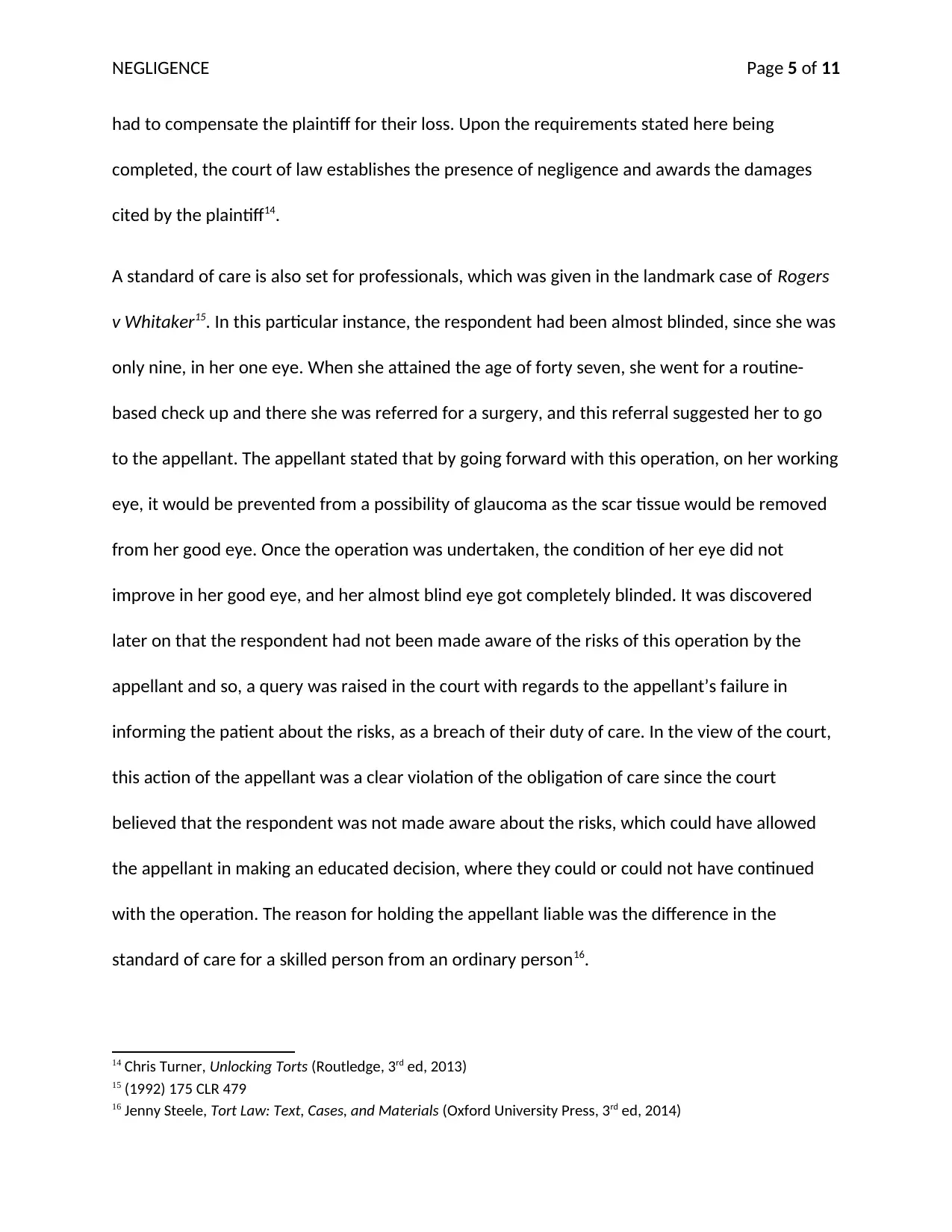
NEGLIGENCE Page 5 of 11
had to compensate the plaintiff for their loss. Upon the requirements stated here being
completed, the court of law establishes the presence of negligence and awards the damages
cited by the plaintiff14.
A standard of care is also set for professionals, which was given in the landmark case of Rogers
v Whitaker15. In this particular instance, the respondent had been almost blinded, since she was
only nine, in her one eye. When she attained the age of forty seven, she went for a routine-
based check up and there she was referred for a surgery, and this referral suggested her to go
to the appellant. The appellant stated that by going forward with this operation, on her working
eye, it would be prevented from a possibility of glaucoma as the scar tissue would be removed
from her good eye. Once the operation was undertaken, the condition of her eye did not
improve in her good eye, and her almost blind eye got completely blinded. It was discovered
later on that the respondent had not been made aware of the risks of this operation by the
appellant and so, a query was raised in the court with regards to the appellant’s failure in
informing the patient about the risks, as a breach of their duty of care. In the view of the court,
this action of the appellant was a clear violation of the obligation of care since the court
believed that the respondent was not made aware about the risks, which could have allowed
the appellant in making an educated decision, where they could or could not have continued
with the operation. The reason for holding the appellant liable was the difference in the
standard of care for a skilled person from an ordinary person16.
14 Chris Turner, Unlocking Torts (Routledge, 3rd ed, 2013)
15 (1992) 175 CLR 479
16 Jenny Steele, Tort Law: Text, Cases, and Materials (Oxford University Press, 3rd ed, 2014)
had to compensate the plaintiff for their loss. Upon the requirements stated here being
completed, the court of law establishes the presence of negligence and awards the damages
cited by the plaintiff14.
A standard of care is also set for professionals, which was given in the landmark case of Rogers
v Whitaker15. In this particular instance, the respondent had been almost blinded, since she was
only nine, in her one eye. When she attained the age of forty seven, she went for a routine-
based check up and there she was referred for a surgery, and this referral suggested her to go
to the appellant. The appellant stated that by going forward with this operation, on her working
eye, it would be prevented from a possibility of glaucoma as the scar tissue would be removed
from her good eye. Once the operation was undertaken, the condition of her eye did not
improve in her good eye, and her almost blind eye got completely blinded. It was discovered
later on that the respondent had not been made aware of the risks of this operation by the
appellant and so, a query was raised in the court with regards to the appellant’s failure in
informing the patient about the risks, as a breach of their duty of care. In the view of the court,
this action of the appellant was a clear violation of the obligation of care since the court
believed that the respondent was not made aware about the risks, which could have allowed
the appellant in making an educated decision, where they could or could not have continued
with the operation. The reason for holding the appellant liable was the difference in the
standard of care for a skilled person from an ordinary person16.
14 Chris Turner, Unlocking Torts (Routledge, 3rd ed, 2013)
15 (1992) 175 CLR 479
16 Jenny Steele, Tort Law: Text, Cases, and Materials (Oxford University Press, 3rd ed, 2014)
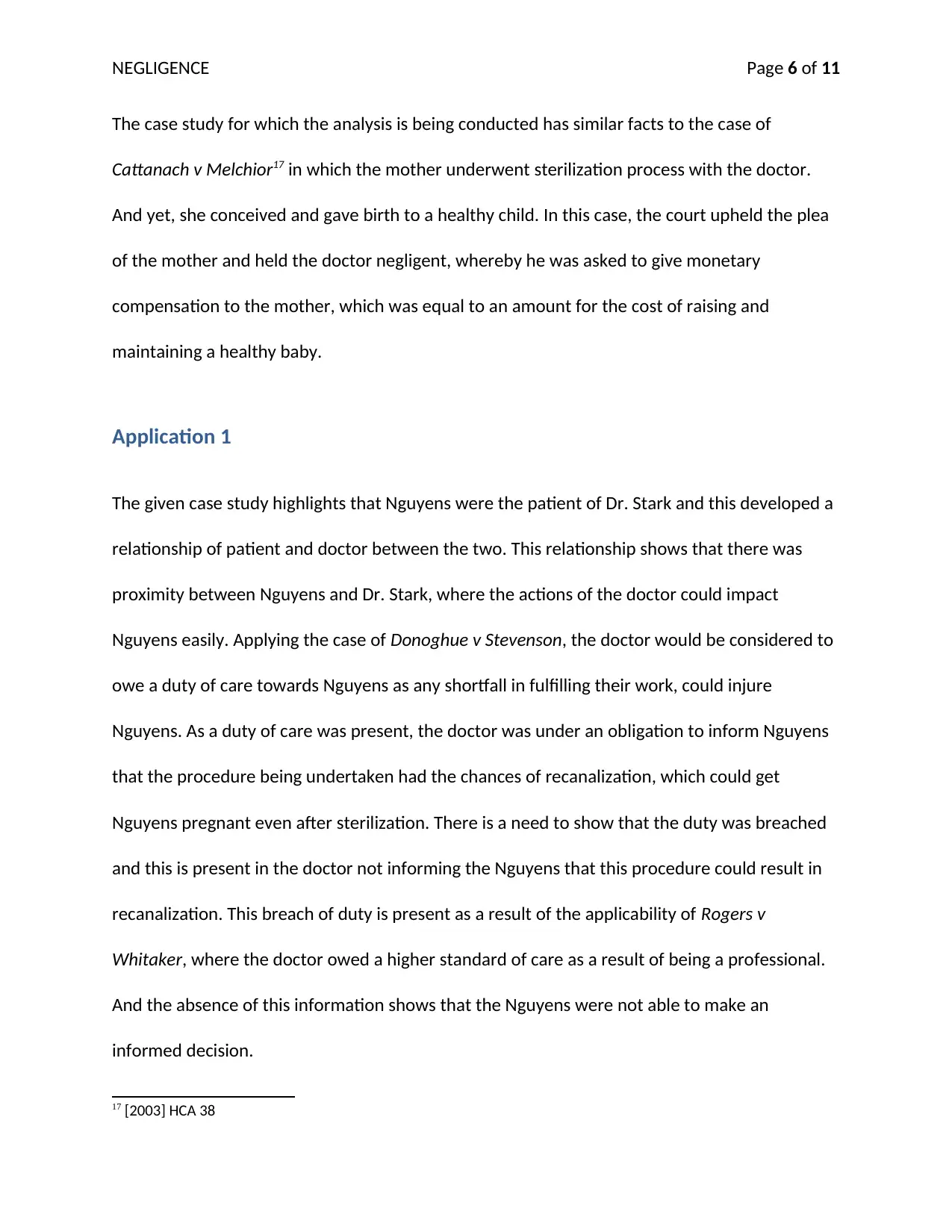
NEGLIGENCE Page 6 of 11
The case study for which the analysis is being conducted has similar facts to the case of
Cattanach v Melchior17 in which the mother underwent sterilization process with the doctor.
And yet, she conceived and gave birth to a healthy child. In this case, the court upheld the plea
of the mother and held the doctor negligent, whereby he was asked to give monetary
compensation to the mother, which was equal to an amount for the cost of raising and
maintaining a healthy baby.
Application 1
The given case study highlights that Nguyens were the patient of Dr. Stark and this developed a
relationship of patient and doctor between the two. This relationship shows that there was
proximity between Nguyens and Dr. Stark, where the actions of the doctor could impact
Nguyens easily. Applying the case of Donoghue v Stevenson, the doctor would be considered to
owe a duty of care towards Nguyens as any shortfall in fulfilling their work, could injure
Nguyens. As a duty of care was present, the doctor was under an obligation to inform Nguyens
that the procedure being undertaken had the chances of recanalization, which could get
Nguyens pregnant even after sterilization. There is a need to show that the duty was breached
and this is present in the doctor not informing the Nguyens that this procedure could result in
recanalization. This breach of duty is present as a result of the applicability of Rogers v
Whitaker, where the doctor owed a higher standard of care as a result of being a professional.
And the absence of this information shows that the Nguyens were not able to make an
informed decision.
17 [2003] HCA 38
The case study for which the analysis is being conducted has similar facts to the case of
Cattanach v Melchior17 in which the mother underwent sterilization process with the doctor.
And yet, she conceived and gave birth to a healthy child. In this case, the court upheld the plea
of the mother and held the doctor negligent, whereby he was asked to give monetary
compensation to the mother, which was equal to an amount for the cost of raising and
maintaining a healthy baby.
Application 1
The given case study highlights that Nguyens were the patient of Dr. Stark and this developed a
relationship of patient and doctor between the two. This relationship shows that there was
proximity between Nguyens and Dr. Stark, where the actions of the doctor could impact
Nguyens easily. Applying the case of Donoghue v Stevenson, the doctor would be considered to
owe a duty of care towards Nguyens as any shortfall in fulfilling their work, could injure
Nguyens. As a duty of care was present, the doctor was under an obligation to inform Nguyens
that the procedure being undertaken had the chances of recanalization, which could get
Nguyens pregnant even after sterilization. There is a need to show that the duty was breached
and this is present in the doctor not informing the Nguyens that this procedure could result in
recanalization. This breach of duty is present as a result of the applicability of Rogers v
Whitaker, where the doctor owed a higher standard of care as a result of being a professional.
And the absence of this information shows that the Nguyens were not able to make an
informed decision.
17 [2003] HCA 38
⊘ This is a preview!⊘
Do you want full access?
Subscribe today to unlock all pages.

Trusted by 1+ million students worldwide
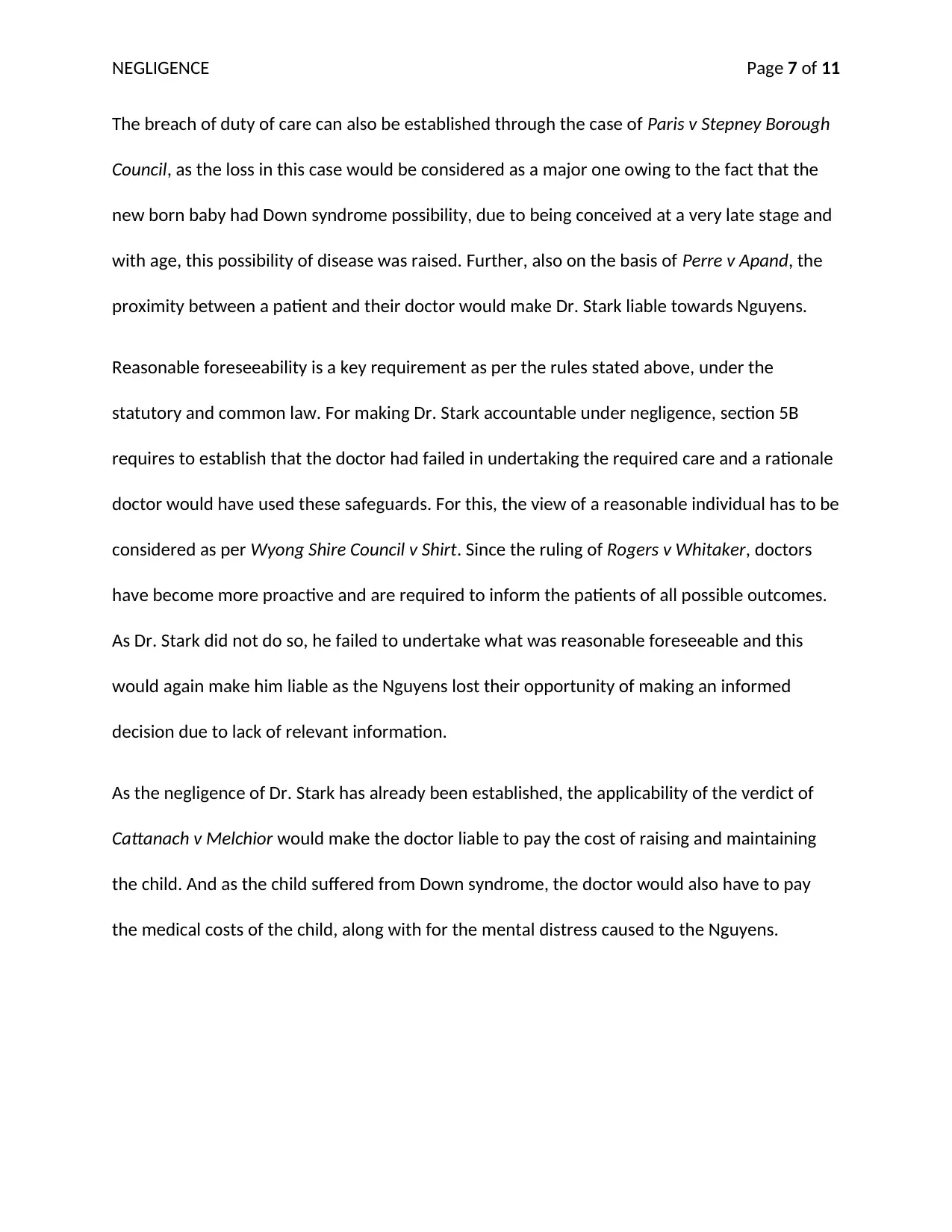
NEGLIGENCE Page 7 of 11
The breach of duty of care can also be established through the case of Paris v Stepney Borough
Council, as the loss in this case would be considered as a major one owing to the fact that the
new born baby had Down syndrome possibility, due to being conceived at a very late stage and
with age, this possibility of disease was raised. Further, also on the basis of Perre v Apand, the
proximity between a patient and their doctor would make Dr. Stark liable towards Nguyens.
Reasonable foreseeability is a key requirement as per the rules stated above, under the
statutory and common law. For making Dr. Stark accountable under negligence, section 5B
requires to establish that the doctor had failed in undertaking the required care and a rationale
doctor would have used these safeguards. For this, the view of a reasonable individual has to be
considered as per Wyong Shire Council v Shirt. Since the ruling of Rogers v Whitaker, doctors
have become more proactive and are required to inform the patients of all possible outcomes.
As Dr. Stark did not do so, he failed to undertake what was reasonable foreseeable and this
would again make him liable as the Nguyens lost their opportunity of making an informed
decision due to lack of relevant information.
As the negligence of Dr. Stark has already been established, the applicability of the verdict of
Cattanach v Melchior would make the doctor liable to pay the cost of raising and maintaining
the child. And as the child suffered from Down syndrome, the doctor would also have to pay
the medical costs of the child, along with for the mental distress caused to the Nguyens.
The breach of duty of care can also be established through the case of Paris v Stepney Borough
Council, as the loss in this case would be considered as a major one owing to the fact that the
new born baby had Down syndrome possibility, due to being conceived at a very late stage and
with age, this possibility of disease was raised. Further, also on the basis of Perre v Apand, the
proximity between a patient and their doctor would make Dr. Stark liable towards Nguyens.
Reasonable foreseeability is a key requirement as per the rules stated above, under the
statutory and common law. For making Dr. Stark accountable under negligence, section 5B
requires to establish that the doctor had failed in undertaking the required care and a rationale
doctor would have used these safeguards. For this, the view of a reasonable individual has to be
considered as per Wyong Shire Council v Shirt. Since the ruling of Rogers v Whitaker, doctors
have become more proactive and are required to inform the patients of all possible outcomes.
As Dr. Stark did not do so, he failed to undertake what was reasonable foreseeable and this
would again make him liable as the Nguyens lost their opportunity of making an informed
decision due to lack of relevant information.
As the negligence of Dr. Stark has already been established, the applicability of the verdict of
Cattanach v Melchior would make the doctor liable to pay the cost of raising and maintaining
the child. And as the child suffered from Down syndrome, the doctor would also have to pay
the medical costs of the child, along with for the mental distress caused to the Nguyens.
Paraphrase This Document
Need a fresh take? Get an instant paraphrase of this document with our AI Paraphraser
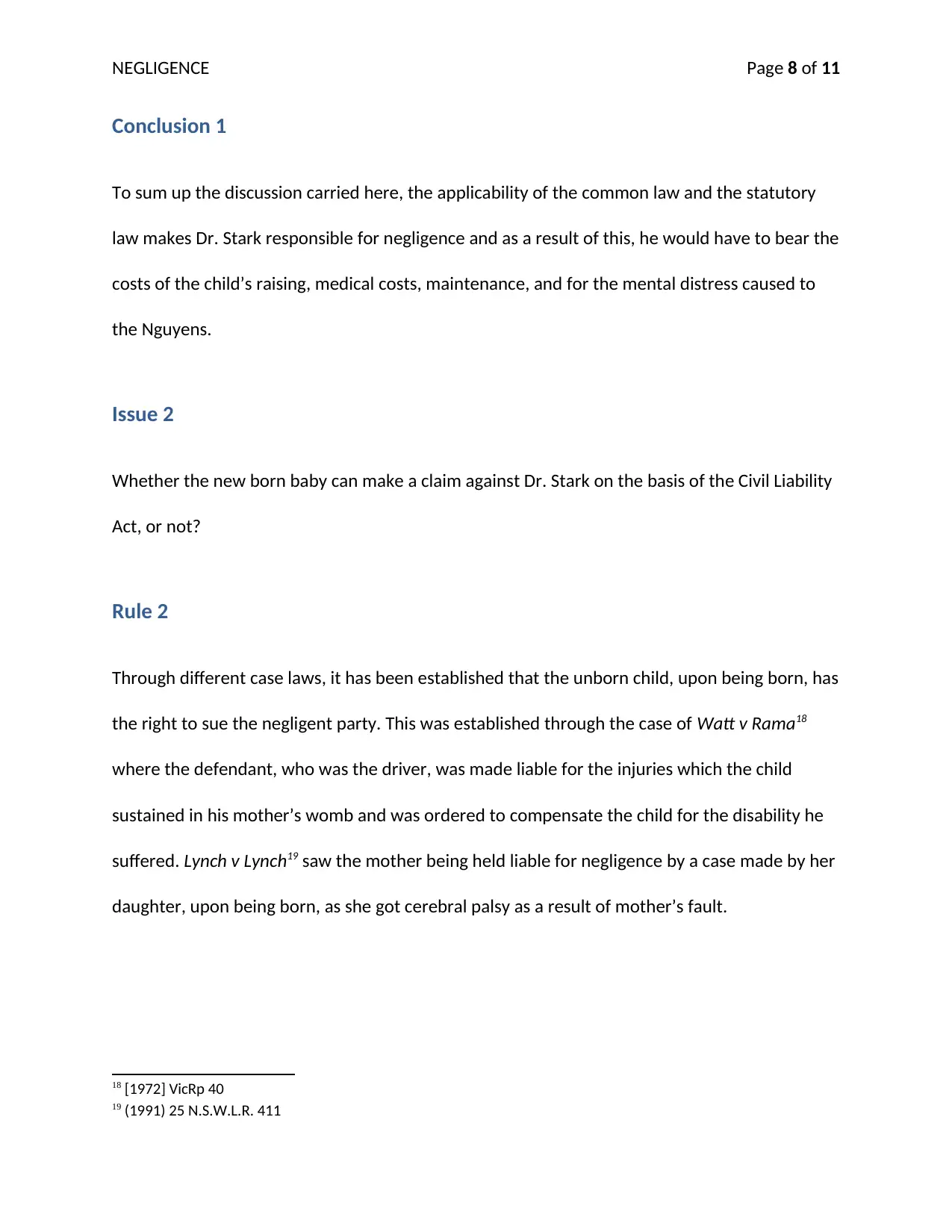
NEGLIGENCE Page 8 of 11
Conclusion 1
To sum up the discussion carried here, the applicability of the common law and the statutory
law makes Dr. Stark responsible for negligence and as a result of this, he would have to bear the
costs of the child’s raising, medical costs, maintenance, and for the mental distress caused to
the Nguyens.
Issue 2
Whether the new born baby can make a claim against Dr. Stark on the basis of the Civil Liability
Act, or not?
Rule 2
Through different case laws, it has been established that the unborn child, upon being born, has
the right to sue the negligent party. This was established through the case of Watt v Rama18
where the defendant, who was the driver, was made liable for the injuries which the child
sustained in his mother’s womb and was ordered to compensate the child for the disability he
suffered. Lynch v Lynch19 saw the mother being held liable for negligence by a case made by her
daughter, upon being born, as she got cerebral palsy as a result of mother’s fault.
18 [1972] VicRp 40
19 (1991) 25 N.S.W.L.R. 411
Conclusion 1
To sum up the discussion carried here, the applicability of the common law and the statutory
law makes Dr. Stark responsible for negligence and as a result of this, he would have to bear the
costs of the child’s raising, medical costs, maintenance, and for the mental distress caused to
the Nguyens.
Issue 2
Whether the new born baby can make a claim against Dr. Stark on the basis of the Civil Liability
Act, or not?
Rule 2
Through different case laws, it has been established that the unborn child, upon being born, has
the right to sue the negligent party. This was established through the case of Watt v Rama18
where the defendant, who was the driver, was made liable for the injuries which the child
sustained in his mother’s womb and was ordered to compensate the child for the disability he
suffered. Lynch v Lynch19 saw the mother being held liable for negligence by a case made by her
daughter, upon being born, as she got cerebral palsy as a result of mother’s fault.
18 [1972] VicRp 40
19 (1991) 25 N.S.W.L.R. 411
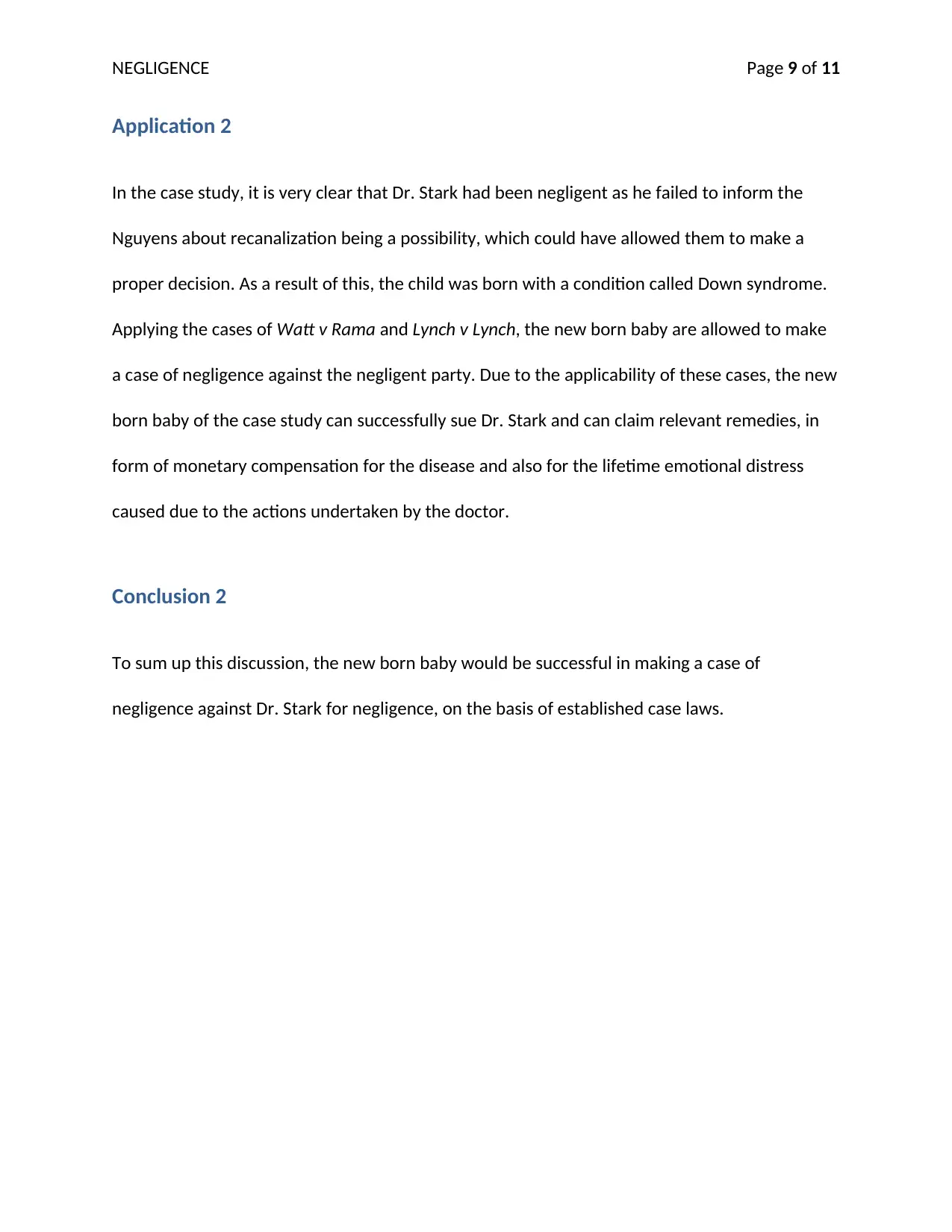
NEGLIGENCE Page 9 of 11
Application 2
In the case study, it is very clear that Dr. Stark had been negligent as he failed to inform the
Nguyens about recanalization being a possibility, which could have allowed them to make a
proper decision. As a result of this, the child was born with a condition called Down syndrome.
Applying the cases of Watt v Rama and Lynch v Lynch, the new born baby are allowed to make
a case of negligence against the negligent party. Due to the applicability of these cases, the new
born baby of the case study can successfully sue Dr. Stark and can claim relevant remedies, in
form of monetary compensation for the disease and also for the lifetime emotional distress
caused due to the actions undertaken by the doctor.
Conclusion 2
To sum up this discussion, the new born baby would be successful in making a case of
negligence against Dr. Stark for negligence, on the basis of established case laws.
Application 2
In the case study, it is very clear that Dr. Stark had been negligent as he failed to inform the
Nguyens about recanalization being a possibility, which could have allowed them to make a
proper decision. As a result of this, the child was born with a condition called Down syndrome.
Applying the cases of Watt v Rama and Lynch v Lynch, the new born baby are allowed to make
a case of negligence against the negligent party. Due to the applicability of these cases, the new
born baby of the case study can successfully sue Dr. Stark and can claim relevant remedies, in
form of monetary compensation for the disease and also for the lifetime emotional distress
caused due to the actions undertaken by the doctor.
Conclusion 2
To sum up this discussion, the new born baby would be successful in making a case of
negligence against Dr. Stark for negligence, on the basis of established case laws.
⊘ This is a preview!⊘
Do you want full access?
Subscribe today to unlock all pages.

Trusted by 1+ million students worldwide
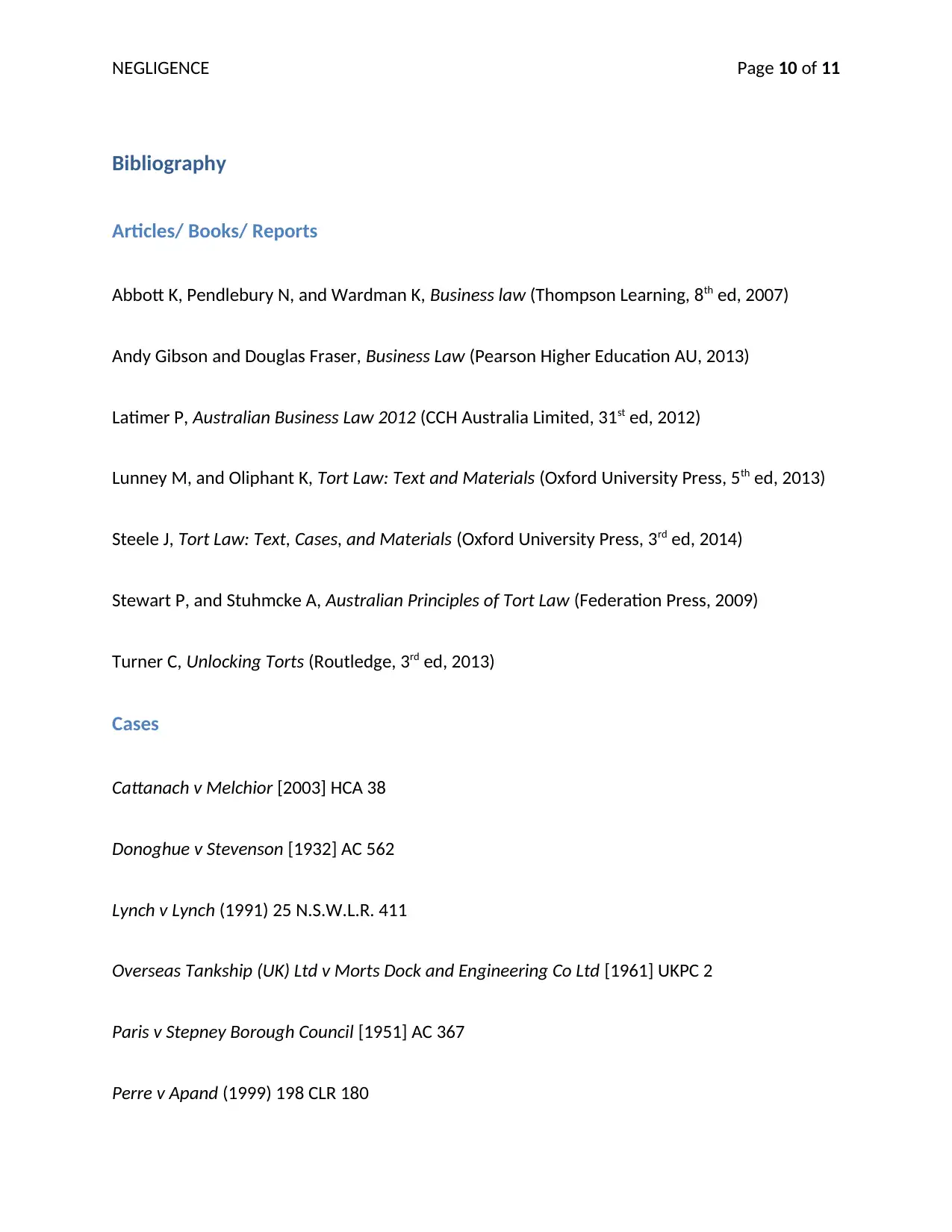
NEGLIGENCE Page 10 of 11
Bibliography
Articles/ Books/ Reports
Abbott K, Pendlebury N, and Wardman K, Business law (Thompson Learning, 8th ed, 2007)
Andy Gibson and Douglas Fraser, Business Law (Pearson Higher Education AU, 2013)
Latimer P, Australian Business Law 2012 (CCH Australia Limited, 31st ed, 2012)
Lunney M, and Oliphant K, Tort Law: Text and Materials (Oxford University Press, 5th ed, 2013)
Steele J, Tort Law: Text, Cases, and Materials (Oxford University Press, 3rd ed, 2014)
Stewart P, and Stuhmcke A, Australian Principles of Tort Law (Federation Press, 2009)
Turner C, Unlocking Torts (Routledge, 3rd ed, 2013)
Cases
Cattanach v Melchior [2003] HCA 38
Donoghue v Stevenson [1932] AC 562
Lynch v Lynch (1991) 25 N.S.W.L.R. 411
Overseas Tankship (UK) Ltd v Morts Dock and Engineering Co Ltd [1961] UKPC 2
Paris v Stepney Borough Council [1951] AC 367
Perre v Apand (1999) 198 CLR 180
Bibliography
Articles/ Books/ Reports
Abbott K, Pendlebury N, and Wardman K, Business law (Thompson Learning, 8th ed, 2007)
Andy Gibson and Douglas Fraser, Business Law (Pearson Higher Education AU, 2013)
Latimer P, Australian Business Law 2012 (CCH Australia Limited, 31st ed, 2012)
Lunney M, and Oliphant K, Tort Law: Text and Materials (Oxford University Press, 5th ed, 2013)
Steele J, Tort Law: Text, Cases, and Materials (Oxford University Press, 3rd ed, 2014)
Stewart P, and Stuhmcke A, Australian Principles of Tort Law (Federation Press, 2009)
Turner C, Unlocking Torts (Routledge, 3rd ed, 2013)
Cases
Cattanach v Melchior [2003] HCA 38
Donoghue v Stevenson [1932] AC 562
Lynch v Lynch (1991) 25 N.S.W.L.R. 411
Overseas Tankship (UK) Ltd v Morts Dock and Engineering Co Ltd [1961] UKPC 2
Paris v Stepney Borough Council [1951] AC 367
Perre v Apand (1999) 198 CLR 180
Paraphrase This Document
Need a fresh take? Get an instant paraphrase of this document with our AI Paraphraser
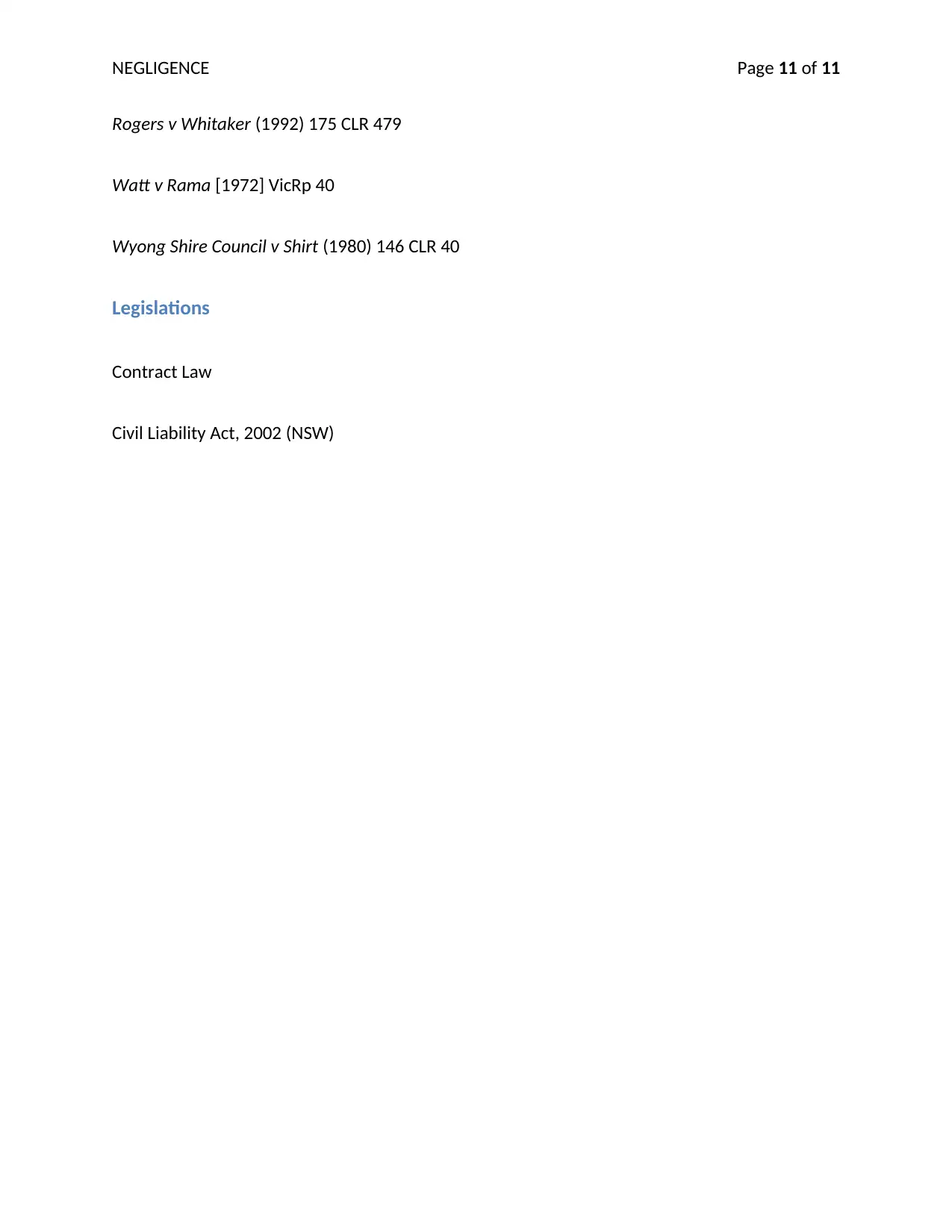
NEGLIGENCE Page 11 of 11
Rogers v Whitaker (1992) 175 CLR 479
Watt v Rama [1972] VicRp 40
Wyong Shire Council v Shirt (1980) 146 CLR 40
Legislations
Contract Law
Civil Liability Act, 2002 (NSW)
Rogers v Whitaker (1992) 175 CLR 479
Watt v Rama [1972] VicRp 40
Wyong Shire Council v Shirt (1980) 146 CLR 40
Legislations
Contract Law
Civil Liability Act, 2002 (NSW)
1 out of 11
Related Documents
Your All-in-One AI-Powered Toolkit for Academic Success.
+13062052269
info@desklib.com
Available 24*7 on WhatsApp / Email
![[object Object]](/_next/static/media/star-bottom.7253800d.svg)
Unlock your academic potential
Copyright © 2020–2025 A2Z Services. All Rights Reserved. Developed and managed by ZUCOL.





